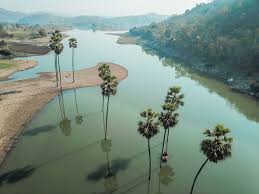Art & Craft
polo Forest
Tucked away in a forest, there are secrets to be revealed. An ancient city, a gateway to Rajasthan. A hiding place for rulers, concealed from enemies, citizens, angry wives, even from the sun, tucked between sacred hills on the east and west. And the mystery of abandonment, decay.
Ancient temples, some still performing their pujas deep within this dense jungle, is itself the larger temple, and the trees themselves are the Gods.
Adivasi settlements, their lives rooted in their connection to the forest, from whom you might learn to listen to the deep hum of the world that envelops these scattered whispers of human constructions.
Friendly Tips: The fig trees, when loaded with fruits, are good places to look out for the endangered Grey Hornbill and Brown-headed Barbet who come to nibble. Grey Hornbills can also be found at a Banyan tree near the campsite, when it is out with its bright red fruit. On another tree on the other side of the camp look for woodpeckers, and fruit birds and prey birds at the top, especially during a particular half hour in the afternoon (the exact time of which continously changes).
Background: The ancient Polo city was built around the river Harnav, an ancient water body spoken of in the Puranas. It is believed to have been established in the 10th century by the Parihar kings of Idar, and was then conquered in the 15th century by the Rathod Rajputs of Marwar. The name is derived from pol, the Marwari word for “gate,” signifying its status as a gateway between Gujarat and Rajasthan. It was built between Kalaliyo in the east, the highest peak in the area, and Mamrehchi in the west, considered sacred by the local adivasis. Together they block sunlight for most of the day, which might provide an explanation for the otherwise mysterious abandonment of the ancient city.
The 400 square km area of dry mixed deciduous forest is most lush between September and December after the monsoon rains when the rivers are full, but at any time of the year it provides a rich wildlife experience. There are more than 450 species of medicinal plants, around 275 of birds, 30 of mammals, and 32 of reptiles. There are bears, panthers, leopards, hyenas, water fowl, raptors, passerines, and flying squirrels (mostly heard, rarely seen), all living under a canopy of diverse plants and trees. During winter, many types of migratory birds occupy the forest; during the rainy season there are wetland birds.
Until recently, this area was not well-known, and saw very few visitors. The numbers have increased dramatically in the last few years, thanks to a few individuals working to promote its beauty. This increased flow comes with a price, however. It is important to remember, as visitors, to approach each destination and its inhabitants, human or otherwise, humbly, openly, and with the awareness that every interaction, no matter how slight, carries its own impact on the area whether we know it or not.
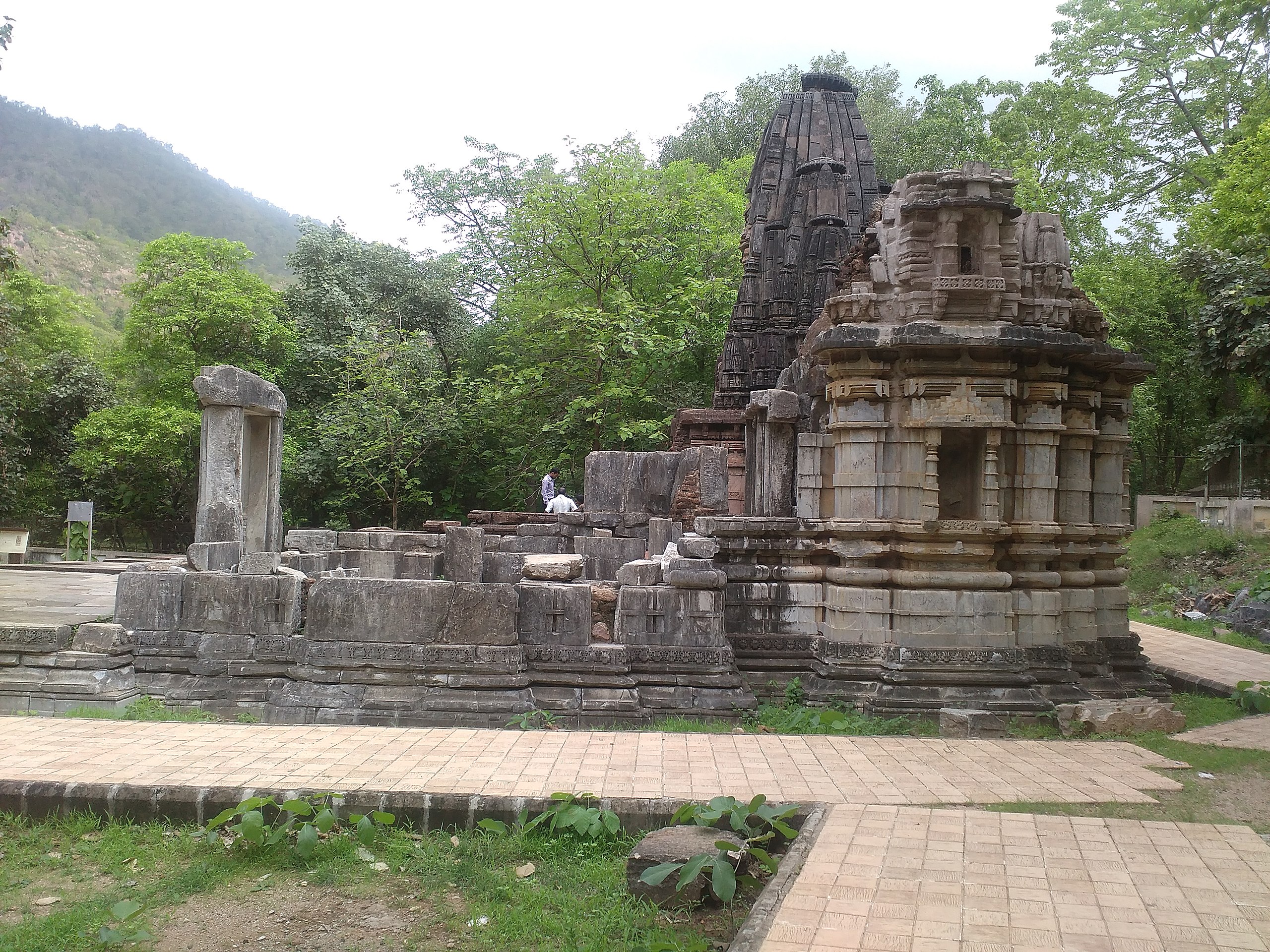

saputara Don Hill Station
Take a deep breath. Disappear. You have entered nature’s womb.
In winter, at the spill of dawn, trek up to the Gandhi Shikhar as the river of light bathes the streams over undulating mountains and the drifting birds, into a magical dance of awakening.
In rains, breathe in the rolling hills of Saputara, echoing green hues, lush with flowers, and watch the meditating rain drops sitting still on sloping leaves. Some of the thickest forest covers in the state envelops you.
In summer, walk carefree on the expanse of the Governor’s hill and see the sun dip into the Saputara lake as the sky begins to shimmer with stars.
As your bus chugs uphill, crisscrossing over the Ambika river, you leave all the congestion of towns and cities far below you and enter the high-spirited world of tribal people. Nestled in the Sahyadri range, at an altitude of about 1000 m, this Dangi enclave derives its name from the Snake God revered by the tribals and translates as ‘the abode of serpents’, Saputara.
In spite of being the only hill station of Gujarat, it is minimally commercialized, still unspoiled.
Involved Tourism: Learn about the rich tribal culture of this region. Visit the Ritambhara Vishva Vidyapeeth and learn about the work of its founder, the highly respected Mrs. Poornima Pakvasa who has worked tirelessly for the empowerment of tribal women for more than five decades. Today, well-known as the ‘Didi of Dang’, she is more than 90 years old. Also other legendary social activists like Ghelubhai Naik and Chhotubhai Naik have started many programs for the inhabitants of the Dangs at their Ashram at Ahwa.
Sardar Sarovar
The Sardar Sarovar Project is one of the largest water resource projects of India covering four major states – Maharashtra, Madhya Pradesh, Gujarat and Rajasthan. Dam’s spillway discharging capacity (30.7 lakhs cusecs) would be third highest in the world.
With 1133 cumecs (40000 cusecs) capacity at the head regulator, and 532 km length, the Narmada Main Canal would be the largest irrigation canal in the world.
The dam is the third highest concrete dam (163 meters) in India, the first two being Bhakra (226 metres) in Himachal Pradesh and Lakhwar (192 meters) in Uttar Pradesh.
The Sardar Sarovar Dam is a gravity dam on the Narmada River near Navagam, Gujarat, India. It is one of the largest and most controversial interstate, multipurpose river valley infrastructure development projects in the country.
Project Details
- Location: Narmada River, Navagam, Gujarat, India
- Proposed final height: 448ft
- Irrigation capacity: 6,900 square miles, most of it in drought-prone areas of Saurashtra and Kutch
- Power generation: 1,450MW power complex
- Reservoir storage capacity: 5,860 cubic hectometers
- Irrigation supply: 1.84 million hectares in Gujarat and some areas of Barmer and Jalore districts of Rajasthan
Power Plant
- Sardar Sarovar – River Bed is a 1,200MW hydro power project
- Sardar Sarovar Canal Solar Power Project is a 10MW solar PV power project
Other Information
- The dam’s spillway discharging capacity (30.7 lakhs cusecs) would be third highest in the world
- The Sardar Sarovar Project is one of the largest water resources projects of India covering four major states – Maharashtra, Madhya Pradesh, Gujarat, and Rajasthan

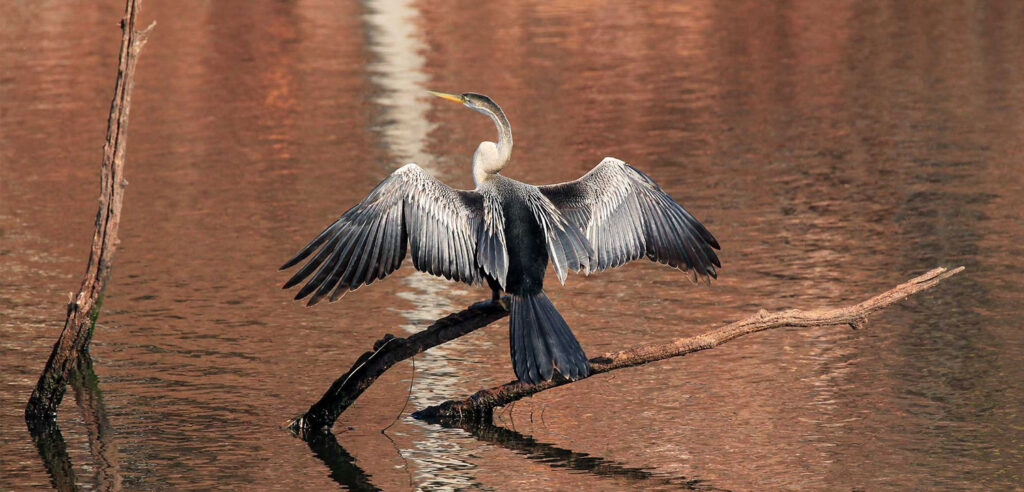
Chhari Dhand Wetland Reserve
Located on the edge of the arid Banni grasslands and the marshy salt flats of the Rann of Kutch in Kutch district, the Chari-Dhand wetland conservation reserve is a protected forest in India. In the local Kutchi language, Chhari means “salty” and Dhand means “shallow wetlands”. This seasonal desert wetland gets swampy during the monsoon season and is fed by north-flowing rivers and surrounding hills.
Bird watchers and ornithologists will find this place a paradise, as it attracts numerous species of migratory birds every year during the monsoon and winter seasons, making it a potential candidate for inclusion in the Ramsar Convention due to its rich biodiversity. The wetland is home to endangered species such as Dalmatian Pelican, Oriental Darter, Black-necked Stork, and Indian Skimmer, while thousands of flamingos, Common cranes, Painted storks, Raptors, and Spoonbills among others can also be spotted here. Additionally, the wetland also attracts chinkara, wolves, caracal, desert cats, and desert foxes, apart from endangered birds.
In conclusion, Chhari Dhand Wetland Reserve is a must-visit destination for bird lovers and wildlife enthusiasts. The wetland reserve offers a unique opportunity to experience the natural beauty and wildlife of Gujarat.
Kilad Nature Education Campsite
This education center is in the southeast part of the park along the Ambika River. It is located at the Dang Forest Division on the way to the Waghai Botanical Garden. It offers visitors a unique and exciting opportunity to stay in the forest and make friends with it. After an evening campfire under the stars, you can spend the night at the center.
In the morning you can hire a guide (Rs. 50) to take you through the forest and tell you the names of trees and their uses, show you leopard tracks, how to recognize birds by their song, and other such secrets. There is a Great! orey tree house made of bamboo which is perfect for early morning birdwatching. Entry to the center is free. Visitors must get permission a few days from the Range Forest Officer, Tel: +91 230 230057. There are essential bath and toilet facilities.
Facilities:
- Orientation Centre
- 4 Cottages
- 10 Tented Accommodation with separate bathing & toilet facilities
- 3 Huts
- Separate Kitchen & Dining places
- Nature Education Camp
- Separate area for Campfire
- Machaans for landscape & wildlife viewing
- The Campsite has a Solar Electricity Supply, hence the tourists are requested to use the electricity only when and where it is required
- Food is available with the help of the ETC (Eco Tourism Committee)
Tips:
Being a responsible nature lover is our way of showing reverence to Mother Earth, a few tips for you to remember –
- Make sure to visit the orientation center first before you start exploring the campsite as that would give a good picture of what you are about to experience during your stay.
- Most of these Eco Campsites use electricity which is generated by using solar energy, hence please use it responsibly.
- No smoking whatsoever (cigarette butts cause many forest fires).
- No flash or intrusive photography (for example, don’t pluck leaves to clear a better view; reposition the camera instead).
- Do not carry any music system or sound-making device along with you and remember to keep them switched off if you are driving around.
- Picking plants or insects is prohibited in any area; do not remove anything from the parks or sanctuaries.
- Do not indulge in any quick or sudden movements to scare off wildlife.
- Do not try going too close to the animals.
- No pets should accompany you.
- No littering. Trash is only to be disposed of in proper receptacles.
- No hunting devices or other weapons should be carried, as well as used.
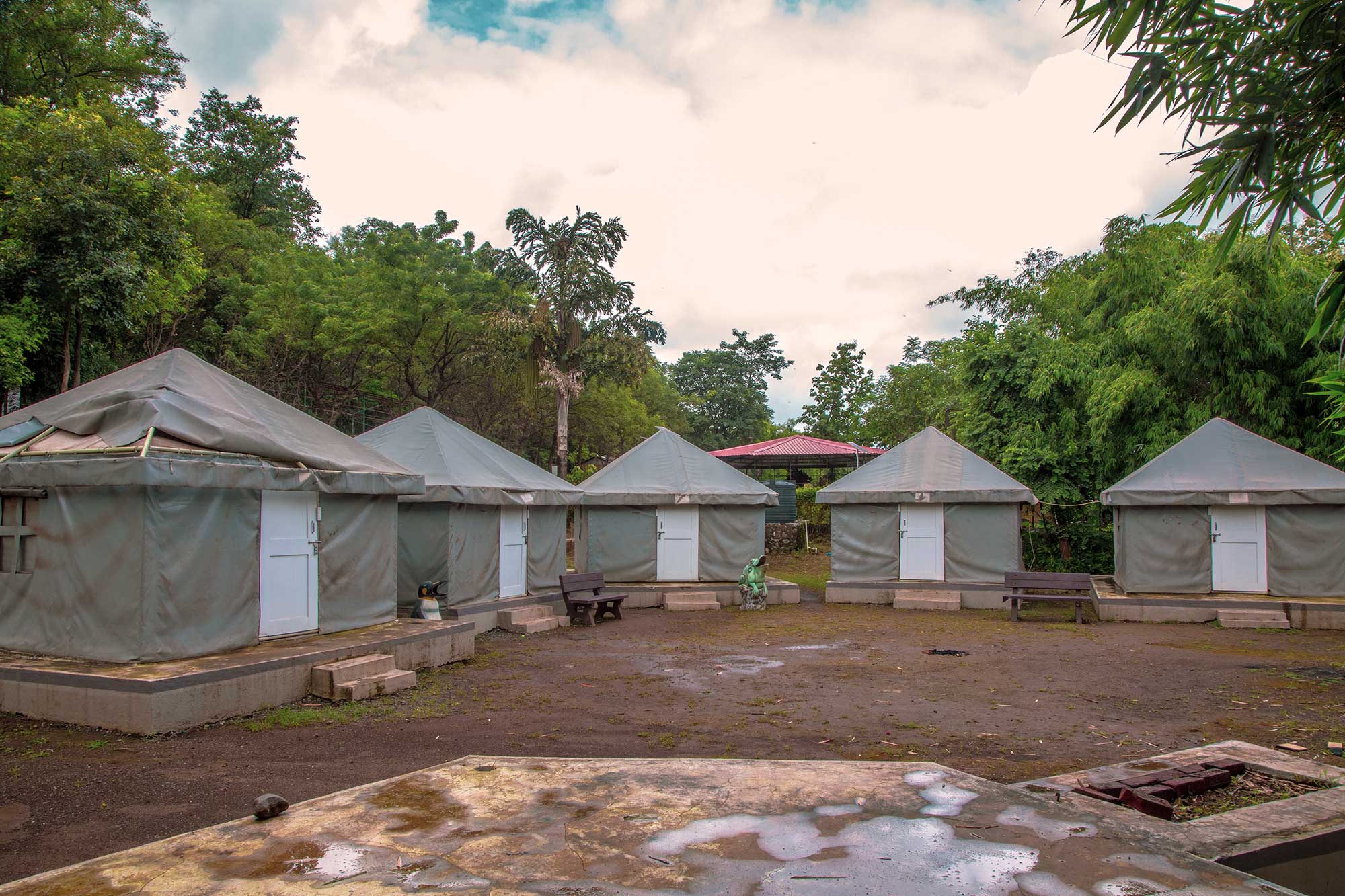
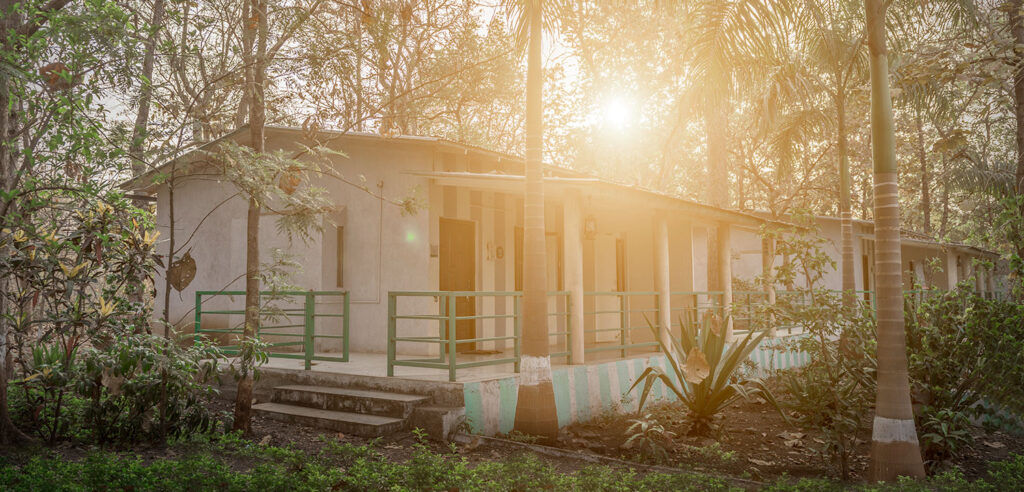
Padam Dungri Eco Tourism
Padamdungari is a campsite located at about 30 kms from Vyara town, and 8 km from Unai village. It is situated amongst the Sahyadri ranges, by the river Ambika. Treks, trails, winding up and down the hillocks, sunset activity, observation towers, relaxing woodlands, and medicinal groves are proposed attractions when you visit Padamdungari.
The scenic site has deep, dense, multi-storeyed forests, genetic diversity, rocky, undulating, & enriched landscapes. The fauna consists of big cats, lesser canines, herbivores, birds, reptiles, aquatic animals.
Background: The campsite consists of Tourist huts, a Reception cum interpretation centre, other Facilities / utilities, nature trails, good approach roads and capacity buildings for local people. A visit to nearby religious places like Chand-surya, Unai Hot Springs & Ghusmaai temples, Waghai botanical gardens, timber workshop, Vansda National Park & Shabri Dham is also possible. Activities like tubing, rafting, floating etc. on river Ambika can also be planned.
Facilities:
Orientation Centre
2 AC & 8 Non AC Cottages
Tented Accomodations with separate bathing & toilet facilities
Separate Kitchen & Dining places
Beautifully, Well-Designed Amphitheatre
Separate area for Campfire
Machaans for landscape & wildlife viewing
A small rescue centre for injured wildlife animals
Tips: Being a responsible nature lover is our way of showing reverence to Mother Earth, a few tips for you to remember –
Make sure to visit the orientation centre first before you start exploring the campsite as that would give a good picture of what you are about to experience during your stay.
Most of these Eco Campsites use electricity which is generated by using solar energy, hence please use it responsibly.
No smoking whatsoever (cigarette butts cause many forest fires).
No flash or intrusive photography (for example, don’t pluck leaves to clear a better view; reposition the camera instead).
Do not carry any music system or sound making device along with you and remember to keep them switched off if you are driving around.
Picking plants or insects is prohibited in any area; do not remove anything from the parks or sanctuaries.
Do not indulge in any quick or sudden movements to scare off wildlife.
Do not try going too close to the animals.
No pets should accompany you.
No littering. Trash is only to be disposed of in proper receptacles.
No hunting devices or other weapons should be carried, as well as used.
Vanil Eco Den
Bhalka Teerth is one of the most magnificent temples of Somnath city. The temple at Bhalka Teerth is known as Mahaprabhuji’s Bethak, and a tulsi tree has been planted in Lord Krishna’s honour. Banyan trees dot the courtyard of the spectacular Krishna temple that is built in sandstone. Inside the shrine is an unusual idol of Shri Krishna in a semi-reclining position. The temple also contains a beautiful tribhangi idol of Lord Krishna playing his flute.
Vanil Eco Den is an Eco Tourism center developed by GSFDC Ltd. located in the lush green western Ghat Forest area of Vansda taluka in Navsari District, Gujarat.
Best Time to Visit
The best time to visit Vanil Eco Den is from July to March.
Attractions and Amenities
- Butterfly Zone
- Tribal Zone
- Herbal Zone
- Adventure Zone
- Wildlife Zone
- Eco Trail
- Cycling in woods
- Wooden Bridge
- Water body
- Dhanvantri Garden
- Furniture & Dhanvantri Products Sales Outlet
- Accommodation: 4 Executive A/c Cottages, 4 Deluxe A/c Cottages
- Amenities: Dining Area- Tribal cafe, Separate Area For Campfire
- Other facilities: Sahyadri Hall for Meeting/Get together, Parking Zone, Drinking water, Rest Hut


Mahal Eco Campsite
The Mahal Eco Campsite is bestowed with rivers and bamboo glides, with excellent walking and trekking options. It is located on the banks of the Purna River, in the middle of the Purna Wildlife Sanctuary and is a part of the Dang Forest Division North. It is surrounded by a vast & rich forest laced with the Purna & Gira rivers.
For an eco-tourist wanting to enjoy birds of moist deciduous forest mixed with bamboo, this is the best place to visit. It’s also near the Girmar Falls which offers a breathtaking view. Best time to visit the campsite is from October to March.
Facilities:
- Orientation Centre
- 4 AC Cottages with attached bath & toilet facilities
- Tented Accomodations with separate bathing & toilet facilities
- Separate Kitchen & Dining places
- Nature Trail
- Separate area for Campfire
- Beautiful two storey Machaans for landscape & wildlife viewing
- Can also have a night trail accompanied by a guide
Tips:
Being a responsible nature lover is our way of showing reverence to Mother Earth, a few tips for you to remember –
- Make sure to visit the orientation centre first before you start exploring the campsite as that would give a good picture of what you are about to experience during your stay.
- Most of these Eco Campsites use electricity which is generated by using solar energy, hence please use it responsibly.
- No smoking whatsoever (cigarette butts cause many forest fires).
- No flash or intrusive photography (for example, don’t pluck leaves to clear a better view; reposition the camera instead).
- Do not carry any music system or sound making device along with you and remember to keep them switched off if you are driving around.
- Picking plants or insects is prohibited in any area; do not remove anything from the parks or sanctuaries.
- Do not indulge in any quick or sudden movements to scare off wildlife.
- Do not try going too close to the animals.
- No pets should accompany you.
- No littering. Trash is only to be disposed of in proper receptacles.
- No hunting devices or other weapons should be carried, as well as used.
Vishal Khadi Eco Campsite
Vishal Khadi Campsite is a campsite situated on the way to Rajpipla-Netrang road. It is around 20 km away from Rajpipla. The site is surrounded by several forest areas, namely, Karjan forest area, Dediyapada forest area and Dang forest area, and fertile agricultural plains and river valleys. The sightseeing includes the bathing ghats on the River Narmada at Chandod and Garudeshwar, the fort at Dabhoi, waterfalls, the Jain temples of Jagadia. One can also go boating to the nearby Karjar River as the back waters of the river extend till the campsite.
The site consists of separate cottages with attached toilets and bathrooms and it also has tent accommodations. It can be reached easily as regular State Transport buses are available from Rajpipla in the morning. It can also be reached by jeeps or sharing auto rickshaws.
Facilities:
- Orientation Centre
- 4 Cottages with attached bath & toilet facilities
- 5 Tented Accomodations with separate bathing & toilet facilites
- Separate Kitchen & Dining places
- Food available with the help of EDC (Eco Tourism Development Committee)
- Separate area for Campfire
- Machaans for landscape & wildlife viewing
- A Watch Tower
Tips:
Being a responsible nature lover is our way of showing reverence to Mother Earth, a few tips for you to remember –
- Make sure to visit the orientation centre first before you start exploring the campsite as that would give a good picture of what you are about to experience during your stay.
- Most of these Eco Campsites use electricity which is generated by using solar energy, hence please use it responsibly.
- No smoking whatsoever (cigarette butts cause many forest fires.)
- No flash or intrusive photography (for example, don’t pluck leaves to clear a better view; reposition the camera instead.)
- Do not carry any music system or sound making device along with you and remember to keep them switched off if you are driving around.
- Picking plants or insects is prohibited in any area; do not remove anything from the parks or sanctuaries.
- Do not indulge in any quick or sudden movements to scare off wildlife.
- Do not try going too close to the animals.
- No pets should accompany you.
- No littering. Trash is only to be disposed off in proper receptacles.
- No hunting devices or other weapons should be carried, as well as used.
